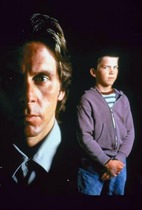Our editor-in-chief Nate Yapp is proud to have contributed to the new book Hidden Horror: A Celebration of 101 Underrated and Overlooked Fright Flicks, edited by Aaron Christensen. Another contributors include Anthony Timpone, B.J. Colangelo, Dave Alexander, Classic-Horror.com's own Robert C. Ring and John W. Bowen. Pick up a copy today from Amazon.com!
Who Can Kill a Child? (1976)
One of the most terrifying monsters in the modern horror film is the murderous child. We can trace this monster back to at least the late 1950s, when an 8-year old girl murdered her classmate and intimidated her mother in The Bad Seed (1956). Not long after, a gaggle of alien pod children took over a quaint British community in Village of the Damned (1960). The notion of malevolent kids continued to horrify audiences well into the 1970s, when Hollywood aligned them with the Devil in wildly popular films like The Exorcist (1973) and The Omen (1976). Perhaps the most unique take on the idea is writer/director Larry Cohen’s film It’s Alive (1974), which proposes that future generations of children will become monstrous by necessity. Cohen has said in several interviews that the mutant baby in his film is a product of evolution – the child becomes ugly and violent in direct response to an ugly and violent world.
Narcisco Ibanez Serrador, a veteran of Spanish television, takes this idea to heart in his film Who Can Kill a Child? (1976). The undeservedly-neglected picture begins with a montage of newsreels – images from Auschwitz, the Indo-Pakistani War, the Korean War, the Vietnam War, and the Civil War in Nigeria – all featuring strong images of children suffering. This opening may be a bit heavy-handed, but it clearly sets up the director’s argument: Children all across the globe are suffering every day as a result of the short-sighted decisions of the adults… Maybe the world would be a better place if the kids were running things...
Tom and Evelyn, a British couple vacationing off the coast of Spain, unwittingly become test-subjects for this theory. When they arrive on the island of Almanzora, it seems as if the place is deserted. Eventually, they learn that all of the adults have been murdered by their kids – think Children of the Corn without the corn. For the first half hour or so, the director and cinematographer do a masterful job of building suspense with minimal sound and action. In fact, I’d go so far as to say that this section of the film is on par with the first half of The Texas Chain Saw Massacre (1974) and far better than Children of the Corn (1984). Like those films, Who Can Kill a Child? makes the viewer jump at shadows, even in broad daylight. The tension is finally broken by a scene that, for some, may be as shocking as the first sighting of Leatherface: a group of children laugh playfully as they take turns using a scythe on a bloody human piñata.
The second act is a bit more uneven. For some reason, the vacationing couple doesn’t consider leaving the island until it is too late, and the husband is constantly leaving his pregnant wife in mortal danger while he tries to figure out what caused the horrific coup d’etat on Almanzora. Something about Lewis Fiander’s performance – specifically, the way he talked about having been on the island before – made me think that he knew more than he was letting on. Whether intentional or not, the ambiguity surrounding Tom’s character prevented me from immediately empathizing with him. In a way, that worked against the film because, as the title suggests, this is a story largely about the way that our heroes (and we, as viewers) respond to the mayhem on the island.
Tom eventually realizes that the adults were killed because they didn’t fight back, and thus the big question is raised in the minds of the viewer: What’s different about Tom… Will he be able to fight back and kill a child, or will he and his wife suffer the same fate as the others? Just as the essential plot can be compared to the plot of Larry Cohen’s breakthrough film, so Tom’s character dilemma might be compared to the plot of Wes Craven’s first film. In Last House on the Left (1972), Craven illustrated his belief that a civilized couple was capable of bloody murder under extreme circumstances. Serrador’s film goes even further, wondering if a civilized couple could kill a child.
If the remainder of the film hinged entirely on this moral dilemma, jaded horror fans might get tired of it pretty quick. Thankfully, the third act is chock full of scenarios in the best tradition of horror – scenarios reminiscent of Invasion of the Body Snatchers (1956), Rosemary’s Baby (1968) and Night of the Living Dead (1968). I’d love to elaborate, but I wouldn’t want to spoil any of these moments for new viewers. The end result is a film that, despite its uneven pacing, belongs in the pantheon of classic horror.
Recognizing this, Dark Sky Films has produced a restored, collector-worthy DVD edition featuring a making-of documentary narrated by Serrador himself. In it, the writer/director discusses his regrets about casting (he originally considered Anthony Hopkins for the lead role) and about the opening montage. He theorizes that the montage would play better at the end of the film, and suggests that it might even be updated to show audiences that the film is just as relevant today as it was in 1976. Pointing to the murdered children of Iraq, he reminds us that “there are lots of children in the world…”
This review is part of Spanish Horror Week, the second of five celebrations of international horror done for our Shocktober 2008 event.








